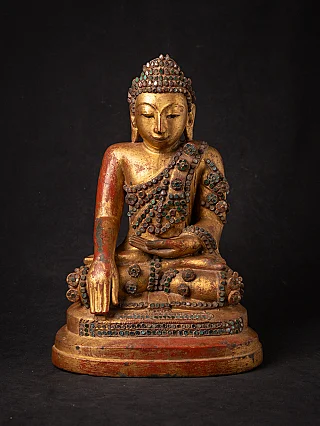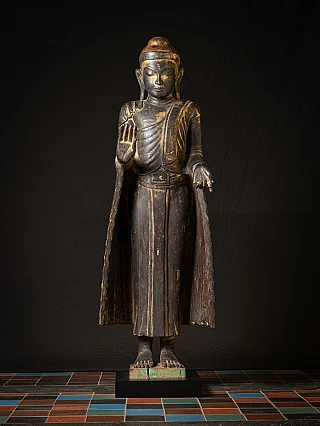Amarapura period: 1789 - 1853

See our Amarapura Buddha statues
Located approximately 11 kilometers south of Mandalay, Amarapura was a prominent ancient capital of the Konbaung Dynasty. Today, the modern town is often called Taungmyo, meaning "the Southern City," distinguishing it from the northern city of Mandalay. The name "Amarapura" translates to "the City of Immortality," reflecting the region's rich history and cultural significance.
History of Amarapura period

The establishment of Amarapura can be traced back to King Bodawpaya, who founded the city in 1783 as a center of political and cultural activity. In 1823, King Bagyidaw moved the capital to Inwa, marking a significant shift in the region's political landscape. However, by 1841, Amarapura regained its status as the capital city, highlighting its enduring importance. This transitional phase culminated in 1857 when King Mindon decided to designate Mandalay as the new capital, with the transfer of power completed by 1860. The dynamic history of Amarapura reflects the ebb and flow of energy within the Konbaung Dynasty, illustrating how the city served as both a political and spiritual heart of the region.
Amarapura is rich in historical significance, boasting several points of interest that attract visitors and scholars alike. Notably, it was home to the first British Embassy in Myanmar, established in 1795, which serves as a testament to the city's role in international relations during the colonial period. The U Bein Wooden Bridge, a remarkable teak structure stretching 1.2 kilometers over the seasonal Taung Thaman Lake, was built in 1786 and remains a symbol of the region's architectural ingenuity.
While the royal palace, grand temples, and fortifications of Amarapura now lie in ruins, many significant pagodas, temples, and monasteries have withstood the test of time. The Mahagandayon Monastery is a vital religious center where over 700 monks reside and carry out their spiritual duties. This monastery is renowned for its disciplined approach to monastic life, attracting visitors who wish to witness the daily rituals and practices central to Buddhist education and culture.
Characteristics
The Buddha statues created during the Amarapura period are referred to as "Pra Nong" in Thailand, reflecting Southeast Asia's cultural exchange and artistic influences. The Amaura style represents a distinctive evolution in Burmese art, characterized by its unique features and techniques. A pivotal moment in this creative development occurred when King Bodawpaya ordered the relocation of the revered Mahamuni Buddha—an Arakanese sacred image—to the royal shrine in Amarapura, thereby solidifying the influence of Arakan art during this era.
The Mahamuni Buddha emerged as the most sacred image in Burma, embodying the region's spiritual essence. This iconic figure, known for its muscular torso and expressive features, significantly influenced the artistic depictions of the Buddha created during this period. The representation of the Buddha during the Amarapura period often emphasized physicality, reflecting the cultural values and spiritual beliefs of the time.
Unlike other artistic styles of the period, Amarapura art moved away from producing Crown Buddha images (such as Jambupati) made from metal or paper mache/lacquerware. These materials were relatively rare in Amarapura art. Instead, artisans preferred to create images from wood, which were intricately carved and gilded with gold leaf. The use of red lacquer added vibrancy to the statues, while the application of white glass inlays provided a striking contrast.
The distinctive features of Amarapura Buddha statues include a round and slightly plump face that closely resembles that of the Mahamuni Buddha, characterized by a downward gaze that conveys a sense of compassion and serenity. The intricate circular patterns adorning the statues' robes, shins, and knees serve as a hallmark of the Amarapura style, showcasing the craftsmanship and artistic innovation of the period. Each statue tells a story, capturing Buddhism's spiritual essence and cultural significance in Burma during the 18th and 19th centuries.
Symbolism
-small.jpg)
The symbolism behind the Amarapura Buddha statues is deeply rooted in Buddhist teachings and philosophy. Each statue represents different aspects of the Buddha's life and teachings, conveying peace, compassion, and enlightenment. The round face and serene expression symbolize tranquility and the path to inner peace, while the downward gaze reflects a connection to the earth and mindfulness practice.
The use of specific gestures, or mudras, in the Amarapura statues further emphasizes their symbolic meanings. For instance, the Bhumisparsha Mudra, in which the Buddha touches the earth, signifies the moment of enlightenment, marking the Buddha's awakening and his commitment to teaching others. Such gestures are not just artistic choices but are imbued with spiritual significance that enhances the viewer's understanding of Buddhist principles.
Evolution and Influences
The Amarapura period marks a significant evolution in Burmese art, influenced by various cultural and historical factors. The relocation of the Mahamuni Buddha was a crucial turning point, leading to the assimilation of Arakanese artistic elements into Amarapura's unique style. This blending of influences is evident in the intricate designs and elaborate embellishments seen in the statues from this period.
Additionally, the interaction with neighboring countries, including Thailand and India, shaped the artistic direction of the Amarapura style. The cross-cultural exchange facilitated the introduction of new techniques and aesthetics, allowing Burmese artisans to innovate while still honoring their traditions. This era represents a rich tapestry of artistic expression, reflecting the diverse influences that contributed to the development of Burmese Buddhism.
Importance
The Amarapura period is crucial in understanding Buddhism's historical and cultural development in Burma. The Buddha statues from this time are vital artifacts that encapsulate the era's religious fervor and artistic achievements. They provide insights into the spiritual beliefs of the Burmese people but also reflect the socio-political dynamics that shaped the region during the Konbaung Dynasty.
Furthermore, preserving Amarapura's artistic legacy is essential for future generations. By studying these statues, we gain valuable knowledge about the evolution of Buddhist art and its role in Myanmar's cultural identity. The ongoing appreciation for Amarapura art underscores its significance as a bridge connecting past and present, allowing people to engage with the rich traditions of Buddhism in Southeast Asia.
In conclusion, the Amarapura period represents a remarkable chapter of Burmese history characterized by artistic innovation and spiritual devotion. The Buddha statues created during this time are not merely decorative objects; they embody the Burmese people's cultural heritage and spiritual identity. The preservation and appreciation of these statues are crucial for maintaining the historical narrative of Amarapura, allowing future generations to connect with their rich past. By studying and valuing the art of this period, we gain insight into a vibrant era of Southeast Asian history where faith and artistry flourished harmoniously.
Share this page






















